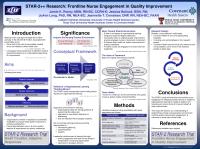The relationship between recurrent placental pathology and recurrent poor pregnancy outcome
View File(s)
- Author(s)
- Details
-
Cara Krulewitch, PhD, CNM, FACNM, FAAN
- Sigma Affiliation
- Pi at-Large
Visitor Statistics
Visits vs Downloads
Visitors - World Map
Top Visiting Countries
| Country | Visits |
|---|
Top Visiting Cities
| City | Visits |
|---|
Visits (last 6 months)
Downloads (last 6 months)
Popular Works for Krulewitch, Cara by View
| Title | Page Views |
|---|
Popular Works for Krulewitch, Cara by Download
| Title | Downloads |
|---|
View Citations
Citations
Poor pregnancy outcome (PPO) is a top agenda item in health and political arenas. Most prominent PPOs are low birth weight (LBW) and preterm delivery (PTD). Effective interventions to maximize pregnancy outcome will diminish their negative impact. The placenta is a diary of the infant's prenatal experiences. Changes in the placenta provide clues to the uterine environment during the pregnancy. Each placental pathology represents a different insult, including severity, duration and type. The Collaborative Perinatal Project of the National Institute of Neurological and Communicative Disorders and Stroke was a longitudinal study of obstetric outcomes in women. The study was conducted from 1959 to 1966 and contains information for 53,518 pregnancies from 10,699 women, including examination of 31,494 placentas (59%). A nested case control study was conducted on this dataset. A sample of 7653 women of black and white races who had two pregnancies during the study period were examined to determine if a relationship existed between the recurrence of PPO and a recurrence of placental pathology. Analysis used several statistical techniques including linear logistic regression and an experimental causal modelling program, TETRAD II. TETRAD II analysis indicated a relationship between marital status and educational incongruity and PPO along with a relationship between recurrent chronic hypoxia and LBW and recurrent infection and PTD. This was the first time TETRAD II was used on real data. Linear logistic regression confirmed these relationships. The risk of repeating LBW or PTD was 1.6 times greater if the woman was unmarried and was 10% greater for each year of greater educational incongruity between the mother and father of the baby. Cigarette smoking in both pregnancies represented 2.1 (1.5-2.9) times greater risk of repeating LBW. There was a 4.2 (1.4-12) times greater risk of repeating PTD if placental chorionic villitis repeated, remaining significant after adjustment for cigarette smoking and social class. There was a 6.5 (1.4-31) times greater risk of repeating LBW if decidual necrosis repeated, remaining significant after adjustment for social class, but becoming marginal when cigarette smoking was included. The main implication of these findings involves the area of preconceptual care for women. This includes preconceptual treatment of infection and nursing support to women at high risk for repeating a PPO.
This dissertation has also been disseminated through the ProQuest Dissertations and Theses database. Dissertation/thesis number: 9226211; ProQuest document ID: 304066055. The author still retains copyright.
This item has not gone through this repository's peer-review process, but has been accepted by the indicated university or college in partial fulfillment of the requirements for the specified degree.
| Type | Dissertation |
| Acquisition | Proxy-submission |
| Review Type | None: Degree-based Submission |
| Format | Text-based Document |
| Evidence Level | Case Study/Series |
| Research Approach | Advanced Analytics |
| Keywords | Premature Babies; Maternal Self-care; Prenatal Smoking |
| CINAHL Subject(s) | Placenta--Physiopathology; Pregnancy Outcomes; Infant, Low Birth Weight; Labor, Premature; Placenta |
| Grantor | University of Maryland, Baltimore |
| Advisor | Kohler, Helen |
| Level | PhD |
| Year | 1992 |
All rights reserved by the author(s) and/or publisher(s) listed in this item record unless relinquished in whole or part by a rights notation or a Creative Commons License present in this item record.
All permission requests should be directed accordingly and not to the Sigma Repository.
All submitting authors or publishers have affirmed that when using material in their work where they do not own copyright, they have obtained permission of the copyright holder prior to submission and the rights holder has been acknowledged as necessary.
Related items
Showing items related by title, author, creator and subjects.
-
Intensifying monitoring and care of preterm and low birth weight babies at Thyolo District Hospital, Malawi
Mikeka, Tabitha; Tewesa, Edith; Chirwa, EllenBACKGROUND - Premature refers to baby being born before 37 completed weeks of gestation and low birth weight is weight at birth of less than 2500 grams. Thyolo District Hospital’s records of 2017 indicated that 119 babies ... -
Nutritional management of the extremely low birth weight infant: An evidence based clinical practice guideline
Lunde, DanaPremature birth has risen steadily over the last decade resulting in an increased number of infants needing neonatal intensive care. The demand for neonatal intensive care has lead to many improvements in the delivery of ... -
Centering Pregnancy Model: EBP for reducing low birth weight infants
Roney, Jamie K. (2016-07-13)Session presented on Thursday, July 21, 2016: Objective(s): To evaluate current research and evidence addressing effects of low-income on women and their fetuses in an effort to identify a population health intervention ... -
The relationship between the birth of a preterm infant and the vulnerable child syndrome using Lessick's Vulnerability Model as a theoretical framework
Martin, Jean T.The primary purpose of this study was to explore the relationship between the birth of a preterm infant and the vulnerable child syndrome. The theoretical framework for the study was Lessick's Vulnerability Model for Nursing ... -
The risks of methemoglobinemia with the use of two antimicrobials in low birth weight infants
Maguire, Denise J. PoirierThe purpose of this study was to determine the degree of risk of methemoglobinemia and extent of skin breakdown when 0.5% chlorhexidine was used as a topical antimicrobial in a population of low birth weight (LBW) infants. ...





